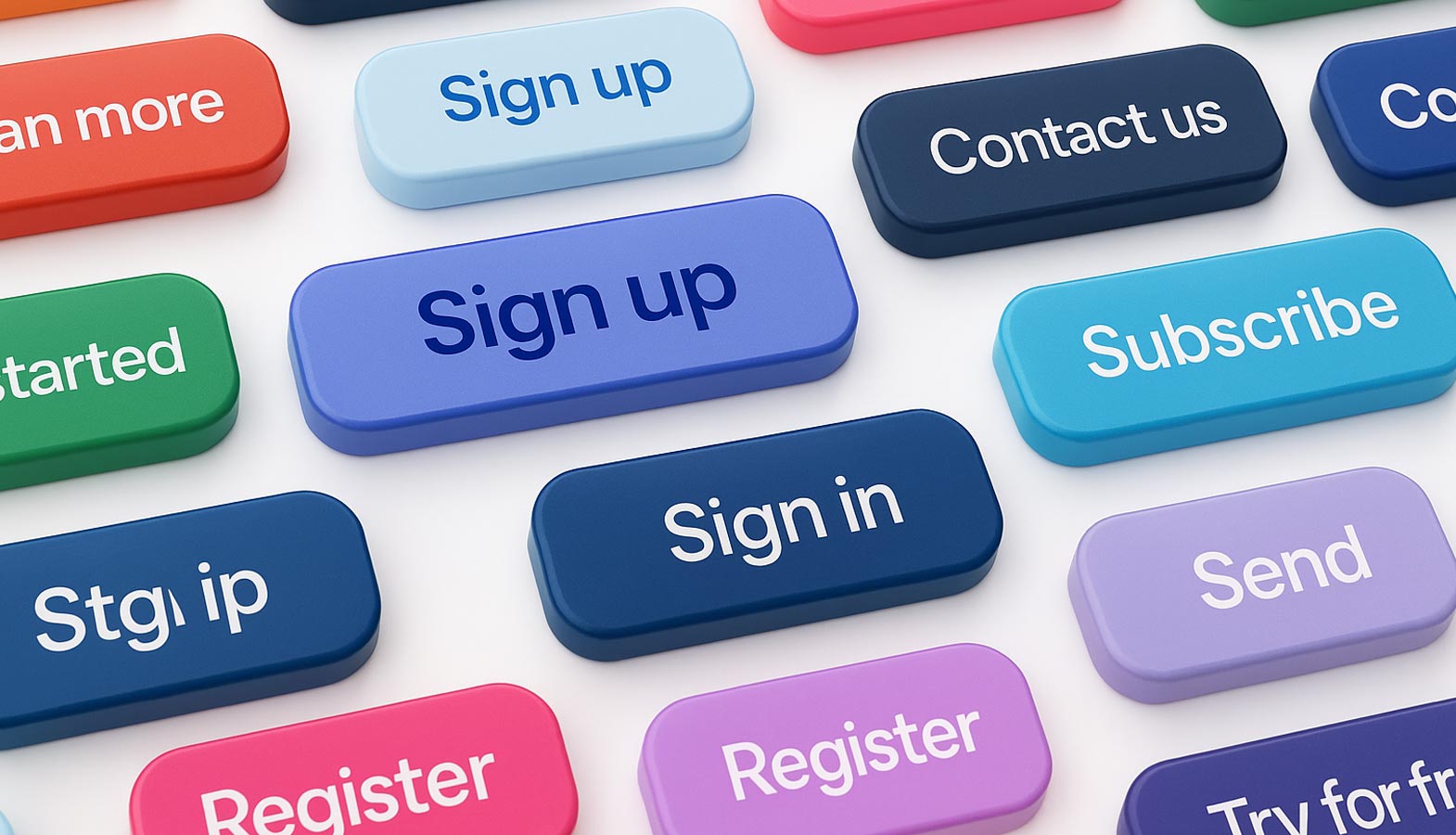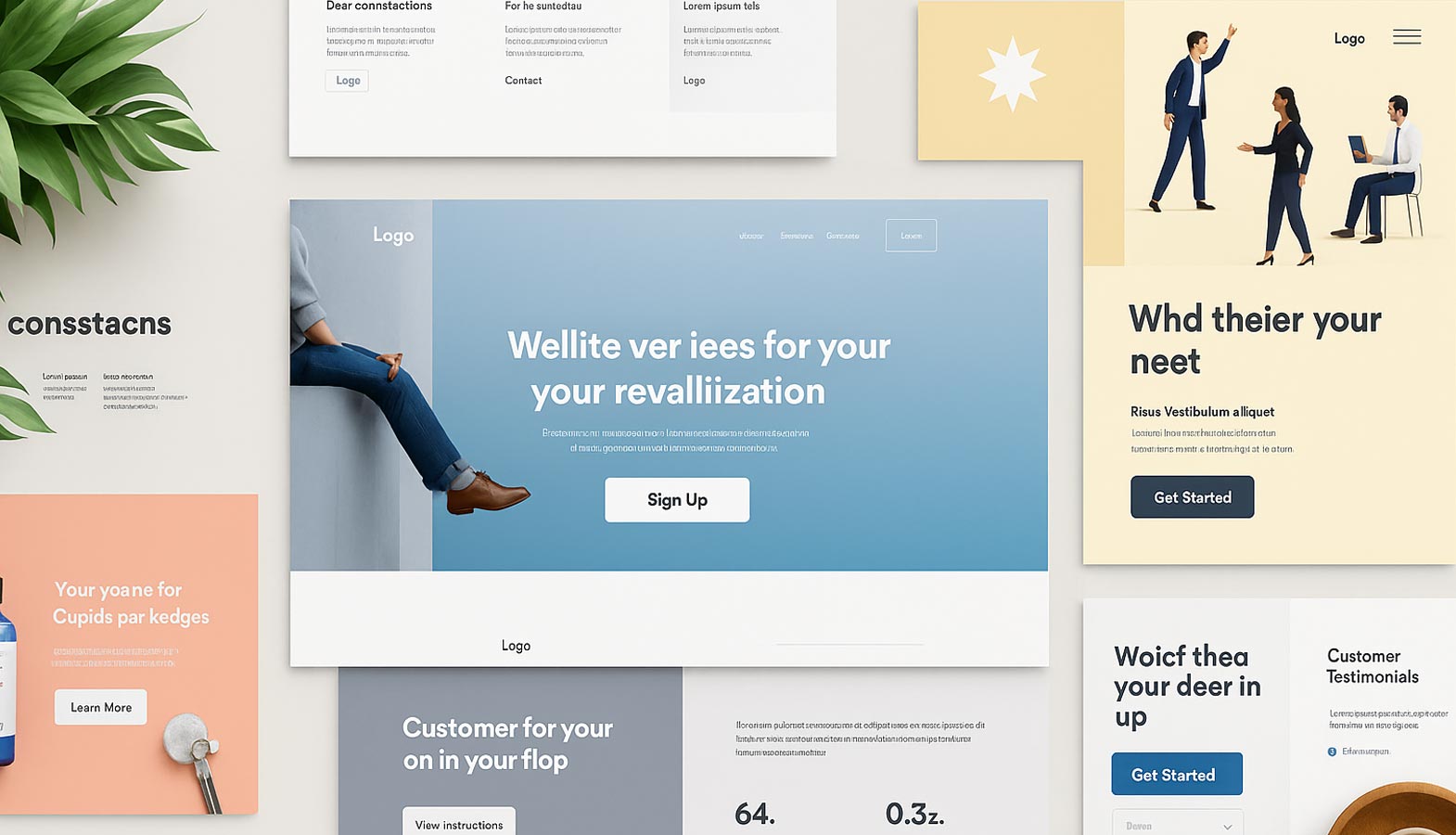The Role of Calls to Action on Your Landing Page
Every click on your website tells a story. The difference between a visitor who bounces and one who converts often comes down to a single element: your call to action. Understanding calls to action in web design is crucial for transforming passive website visitors into active participants who engage with your content, subscribe to your services, or become paying customers.
A well-designed CTA serves as the bridge between browsing and converting, guiding users through your conversion funnel with clear direction and compelling messaging. In this comprehensive guide, we’ll explore the fundamental principles of effective CTA design, including how to craft compelling calls that directly address user needs and motivations, from visual elements and copywriting techniques to strategic placement and optimization strategies that drive measurable results.
Whether you’re designing landing pages for marketing campaigns, optimizing your home page for conversions, or improving the user experience across your site, mastering the art and science of calls to action will significantly impact your website conversions and business success.
What Are Call-to-Action Elements in Web Design
A call to action in web design refers to any interactive element specifically designed to encourage users to take a desired action on your website. These elements, often called cta stands, serve as digital signposts that guide website visitors toward specific goals, whether that’s making a purchase, signing up for a newsletter, downloading a free ebook, or requesting more information about your services. Cta stands play a key role in guiding users to take specific steps by making the desired action clear and prominent.

CTAs bridge the gap between passive content consumption and active user engagement on web pages. Unlike regular text or images that provide information, CTAs demand attention and prompt immediate action. They are designed to capture the user’s attention quickly, transforming your website from a static information source into an interactive platform that drives business objectives.
Visual characteristics distinguish CTAs from regular content elements through strategic design choices. A well-designed cta stand can make a call-to-action button more prominent and draw attention, ensuring it stands out on the page. Effective call-to-action buttons typically feature contrasting colors that make them stand out from the surrounding design, bold typography that enhances readability, and distinctive shapes or borders that signal their interactive nature. The use of white space around CTAs enhances their visibility and focus, making them more eye-catching and easier to understand. The visual prominence ensures that even users scanning your page can identify where to take action.
Color choices for CTAs play a key role in their effectiveness. Different colors in CTA design can evoke different emotions in users, influencing their actions and decision-making processes. The right combination of color and contrast is crucial for making CTAs visually appealing and effective within your overall design and color psychology strategy.
The role of CTAs in guiding user flow through website navigation cannot be overstated. They create a logical progression through your site, leading users from awareness to consideration to action. Well-placed CTAs reduce friction in the user journey and provide clear next steps at every stage of the conversion funnel, preventing visitors from becoming confused or overwhelmed by too many options.
Why CTAs Are Essential for Web Design Success
CTAs convert passive website visitors into active participants and customers by providing clear pathways for engagement. Without effective calls to action, even the most compelling content and attractive design may fail to generate the conversions your business needs. They serve as the crucial link between user interest and meaningful action, helping guide prospects through the marketing funnel so they eventually convert.
They provide clear direction to prevent user confusion and decision paralysis. When users arrive on your web page, they need immediate clarity about what actions they can take and which action you want them to prioritize. A well-designed CTA eliminates guesswork and reduces the cognitive load required for users to make decisions about their next steps.
Strategic CTA placement reduces bounce rates and increases time on site by giving users compelling reasons to continue exploring your content. When visitors see relevant, valuable calls to action that align with their interests and needs, they’re more likely to engage further with your site rather than returning to search results or navigating away entirely. These strategies can attract more users and improve conversion rates.
Well-designed CTAs improve overall user experience by creating intuitive pathways through your website’s information architecture. They help users accomplish their goals efficiently while simultaneously advancing your business objectives. This alignment between user needs and business goals creates a win-win scenario that builds trust and encourages repeat visits. The broad impact of CTAs and these strategies is seen across many industries.
The impact of effective CTAs extends beyond immediate conversions. They help establish clear communication patterns with your target audience, set expectations for the value users will receive, and create consistent touchpoints throughout the customer journey. This systematic approach to user engagement builds stronger relationships and increases customer lifetime value. CTAs can also help attract new customers by creating a sense of community or social proof, encouraging first-time visitors to take action.
Action Buttons and Their Role in Web Design
Action buttons, often referred to as call to action (CTA) buttons, are a powerful tool in web design for encouraging users to take meaningful steps on your website. Whether you want users to download a free ebook, sign up for a newsletter, or complete a purchase, an effective CTA button can make all the difference in achieving your desired action. The key to creating a successful CTA button lies in understanding your target audience and aligning the button’s design and message with their needs and motivations.
A well-crafted CTA button should be visually prominent, using design elements that draw the user’s attention without overwhelming the rest of the page. Clear, concise text that communicates exactly what will happen when the button is clicked helps users feel confident in their decision. In modern web design, tools like Google Optimize allow businesses to test different CTA button styles, colors, and placements to see which combinations lead to the most website conversions. By continually refining your call to action cta elements, you can create a seamless user experience that guides users toward your business goals and maximizes conversions.
The Importance of Call-to-Action Buttons in Web Design
Call-to-action buttons are essential for guiding site visitors toward the next step in their journey, making them a cornerstone of effective web design. A strategically placed CTA button encourages users to take the desired action, whether that’s making a purchase, signing up for a newsletter, or exploring more content. Many company websites rely on CTA buttons across landing pages, email campaigns, and even social media ads to drive engagement and boost conversion rates.
To ensure your call-to-action buttons stand out, use contrasting colors that catch the eye, straightforward language that leaves no room for confusion, and a placement that’s impossible to miss. Creating an effective cta button isn’t just about aesthetics—it’s about understanding what motivates your users and making it as easy as possible for them to act. By focusing on these elements, businesses can increase website conversions, drive more sales, and achieve their marketing objectives across all pages and platforms.
Primary Types of CTAs in Web Design
Understanding different CTA categories and their specific use cases enables you to select the most appropriate call to action for each situation. It is crucial to highlight the main CTA so it stands out as the most prominent element, guiding users toward the primary conversion goal. The type of CTA you choose should align with your users’ intent, their position in the marketing funnel, and your specific business objectives for that page or interaction.
When using multiple CTAs, consider the strategic use of a second cta to address different user intents, while secondary ctas can support users who need more information before taking action. When to use each type depends on factors such as user behavior patterns, the complexity of your offering, and the level of commitment you’re requesting from potential customers. Testing different CTA types is essential to determine which approach leads to the most conversions. Different CTA types serve different purposes in nurturing prospects from initial awareness through to conversion and retention.

Lead Generation CTAs
Newsletter signup forms with compelling value propositions serve as low-friction entry points for building relationships with potential customers. Effective CTAs on these forms can significantly increase sign-ups for newsletters and exclusive content. These CTAs work best when they clearly communicate the benefits users will receive, such as exclusive content, industry insights, or special offers. The key is positioning your newsletter as a valuable resource rather than just another marketing channel.
Free resource downloads like eBooks, whitepapers, and templates offer substantial value in exchange for contact information. These lead magnets should directly address specific pain points or interests of your target audience. Free templates, in particular, provide immediate utility while demonstrating your expertise and the quality of your paid offerings.
Email capture for exclusive content or early access offers creates a sense of exclusivity that can motivate users to share their information. This approach works especially well for product launches, event announcements, or premium content releases. The perceived value of being “first” or “exclusive” can significantly increase conversion rates.
Contact form submissions for consultations or quotes represent higher-intent actions that typically indicate users are further along in their decision-making process. These CTAs should emphasize the personalized value and expertise users will receive, making it clear that the consultation will provide actionable insights specific to their situation.
E-commerce CTAs
“Add to Cart” buttons with clear product selection options should eliminate any confusion about what users are purchasing. These CTAs work best when they’re prominently displayed, use action words that create urgency, and include relevant product details like size, color, or quantity. The button should be visually distinct and easily accessible on both desktop and mobile devices. Effective CTA strategies enhance user navigation and engagement within an online store, making it easier for customers to find and purchase what they want.
“Buy Now” options for immediate purchase without cart interaction reduce friction for users who have already decided to purchase. This streamlined approach works particularly well for single-item purchases, digital products, or when you want to minimize the steps between interest and conversion. However, be careful not to skip important information like shipping costs or payment options.
“Save for Later” or wishlist functionality serves customers who need more time to make purchasing decisions. This feature is especially valuable for higher-priced items or complex purchases where comparison shopping is common, and it is particularly useful for customers interested in DIY fashion or customization options. It keeps your products top-of-mind while allowing users to continue their research process.
“View Product Details” links work well for complex or high-consideration items where customers need comprehensive information before making a purchase decision. These CTAs should lead to detailed product pages that address common questions and objections while maintaining clear paths to purchase.
Engagement CTAs
Social media follow buttons integrated into website design help expand your audience across multiple platforms while keeping users engaged with your brand beyond their initial website visit. These CTAs should be strategically placed without being intrusive, and should clearly communicate the type of content users can expect on each platform. Additionally, placing call-to-action buttons within a Facebook ad can be highly effective for driving engagement and conversions, as Facebook ads allow you to target specific audiences and encourage actions like following your page or engaging with a promotion.
“Read More” links for blog posts and article previews encourage deeper engagement with your content while helping users discover additional resources. These CTAs should provide enough context about what users will find when they click, ensuring that the expanded content delivers on the promise made in the preview.
Video play buttons with clear viewing expectations help users understand the time commitment and content type before they engage. Include information like video length, topic, and format to help users make informed decisions about whether to invest their time in watching.
“Share” buttons for content distribution across platforms should be easy to find and use, but not so prominent that they distract from your primary conversion goals. Consider which sharing options are most relevant to your audience and content type, rather than including every possible platform.
Design Principles for Effective CTAs
Visual hierarchy techniques make CTAs stand out from other elements by using size, color, positioning, and spacing strategically. The most effective call-to-action button draws the user’s attention immediately while maintaining harmony with the overall design aesthetic. This balance requires careful consideration of how different visual elements are created to guide the user’s eye and enhance CTA effectiveness.
Color psychology and contrast considerations for maximum visibility involve understanding how different colors affect user emotions and behavior. While there’s no universally “best” color for CTA buttons, high contrast with the surrounding design is essential. Your CTA design should also align with your brand colors while ensuring accessibility for users with visual impairment.
Typography choices enhance readability and urgency through font selection, size, and weight. The button text should be easily readable at various screen sizes and distances. Consider using slightly bolder or larger text for CTAs compared to regular body text, but avoid making them so large that they appear overwhelming or unprofessional.
Size and spacing guidelines ensure optimal click targets, especially on mobile devices where users interact with touch rather than precise mouse clicks. Following established usability principles helps create CTAs that are both visually appealing and functionally effective across all devices and interaction methods.
Effective cta works are designed, tested, and optimized to improve user engagement and conversion rates. When performing A/B testing, it is important to keep elements consistent on the same page to accurately measure the impact of changes and improve conversion rates.

Visual Design Elements
Button styling with rounded corners, shadows, and hover effects creates visual depth and interactivity cues that help users understand which elements are clickable. Subtle shadows can make buttons appear elevated from the page, while hover effects provide immediate feedback that confirms the element is interactive. However, avoid overly elaborate effects that might distract from the CTA’s primary purpose.
Color combinations that create sufficient contrast for accessibility ensure that all users can see and interact with your CTAs effectively. This includes users with various forms of color blindness or visual impairments. Tools like contrast checkers can help you verify that your color choices meet accessibility guidelines while still achieving your design goals.
Icon usage can reinforce CTA messaging and improve recognition when used appropriately. Simple, universally understood icons like arrows for “next” actions or shopping cart symbols for purchase buttons can enhance comprehension. However, icons should supplement rather than replace clear text, as their meanings can be ambiguous across different cultures and contexts.
Consistent styling across website pages creates a cohesive user experience and builds familiarity with your CTA patterns. When users learn to recognize your CTA style, they can more quickly identify action opportunities throughout your site. This consistency should extend to colors, fonts, sizing, and spacing across all pages and sections.
Mobile-First CTA Design
Touch-friendly button sizes following established guidelines ensure that mobile users can easily tap your CTAs without accidentally hitting adjacent elements. The recommended minimum touch target size is 44 pixels, though larger sizes often perform better, especially for primary actions. Consider the context of use and the importance of each CTA when determining optimal sizing.
Thumb-zone placement for one-handed mobile navigation takes into account how most users hold and interact with their devices. The most accessible areas for thumb interaction are typically in the center and bottom portions of the screen. Placing important CTAs in these zones can significantly improve usability and conversion rates on mobile devices.
Responsive scaling across different screen sizes and orientations ensures that your CTAs remain effective regardless of how users access your site. This involves more than just resizing elements; it may require repositioning CTAs, adjusting spacing, or even changing the hierarchy of different actions based on screen real estate.
Loading states and feedback for slower mobile connections help maintain user engagement even when network conditions aren’t optimal. Providing visual feedback when users tap a CTA button, such as a loading spinner or color change, confirms that their action was registered and encourages them to wait for the response rather than tapping repeatedly or abandoning the process.
Making the Most of Action Buttons
To maximize the impact of action buttons, it’s crucial to create a clear and compelling call to action that resonates with your users. The cta button should be easy to spot, simple to read, and deliver a message that encourages users to take the next step. Using strong action words like “Sign up,” “Download,” or “Buy now” can create a sense of urgency and motivate users to complete the desired action.
Highlighting different benefits—such as “Get your free ebook” or “Start your free trial”—can further entice users by showing the value they’ll receive. Testing various cta button designs and placements is also key; what works for one audience or web design may not work for another. By continually refining your approach and focusing on what encourages users to act, you can optimize your site for more conversions and a better overall user experience.
Writing Compelling CTA Copy
Action-oriented language clearly communicates expected outcomes and removes ambiguity about what will happen when users click your CTA. The most effective CTA copy uses strong action words that create mental images of the benefits users will receive. The wording of your CTA can significantly influence users’ feelings, making them feel understood, encouraged, and motivated to take action. This approach helps users feel confident about taking the next step because they understand exactly what to expect.
Urgency and scarcity techniques motivate immediate action by creating a sense that the opportunity is limited or time-sensitive. However, these techniques must be used authentically to maintain trust. False urgency or artificial scarcity can damage your credibility and harm long-term customer relationships. Focus on genuine time-sensitive offers or limited availability.
Personalization strategies using first and second-person language create a more direct connection with users by speaking to them individually rather than addressing a general audience. Phrases like “Start your free trial” or “Get your customized report” feel more personal and relevant than generic alternatives like “Start free trial” or “Get report.”
A/B testing different copy variations provides data-driven insights into what resonates best with your specific audience. Small changes in wording can sometimes produce significant differences in conversion rates. Test different action words, benefit statements, and urgency language to optimize your CTA copy over time.
Copywriting Best Practices
Keep CTA text under 5 words for quick comprehension and maximum impact. Shorter CTAs are easier to scan and understand quickly, which is especially important for mobile users or those rapidly browsing your content. Every word should serve a specific purpose in motivating action or communicating value.
Use strong action verbs like “Get,” “Start,” “Discover,” and “Join” to create momentum and energy in your CTA copy. These words imply forward movement and positive outcomes, making users more likely to engage. Choose verbs that align with the specific action you want users to take and the emotional tone you want to create.
Include benefit-focused language that answers “What’s in it for me?” by clearly communicating the value users will receive. Rather than focusing solely on what you want users to do, emphasize what they’ll gain from taking action. This user-centric approach increases the perceived value of clicking your CTA.
Avoid generic phrases like “Click Here” or “Submit” in favor of specific actions that describe the actual outcome. Generic language doesn’t communicate value or create excitement about the next step. More specific alternatives like “Download Free Guide” or “Schedule Consultation” set clear expectations and highlight benefits.
Strategic CTA Placement in Web Design
Above-the-fold placement ensures immediate visibility upon page load, capturing users’ attention before they have a chance to scroll or navigate away. This positioning is particularly important for primary CTAs that support your main conversion goals. However, above-the-fold placement should be balanced with providing enough context for users to understand the value proposition.
End-of-content positioning works well for engaged readers and viewers who have consumed your material and are ready to take the next logical step. These CTAs can be more specific and action-oriented since users have already demonstrated interest by reading or viewing your content completely. This placement often achieves higher conversion rates among engaged users.
Sidebar and floating CTAs provide persistent availability without interrupting the main content flow. These elements remain visible as users scroll, ensuring that conversion opportunities are always accessible. However, they should be designed carefully to avoid creating distraction or appearing intrusive to the user experience.
Exit-intent popup timing offers last-chance conversion opportunities for users who are about to leave your site. While these can be effective for capturing otherwise lost visitors, they should be used sparingly and only with genuinely valuable offers to avoid creating negative user experiences that damage your brand reputation.
Page-Specific Placement Strategies
Homepage CTAs in hero sections and key feature areas should focus on your primary value proposition and main conversion goal. Since the home page often serves as the entry point for many site visitors, these CTAs should be broad enough to appeal to different user segments while still being specific enough to communicate clear value.
Product page placement near pricing and feature descriptions takes advantage of the context where users are actively evaluating your offering. These CTAs should address common objections and make it easy for interested users to move forward in the purchase process. Consider including multiple CTA options for users at different stages of decision-making.
Blog post CTAs within content and at article conclusions should relate directly to the topic being discussed while providing natural next steps for readers who found value in your content. In-content CTAs can offer related resources, while end-of-article CTAs might focus on broader engagement opportunities like newsletter signups or consultation requests.
Landing page single-focus CTA positioning for campaign conversions eliminates distractions and guides users toward one specific action. These pages should have a clear hierarchy that leads naturally to the primary CTA, with minimal navigation options that might divert attention from the conversion goal. Every element should support the main call to action.
Using a Single CTA Button to Drive Results
Focusing on a single CTA button can be a highly effective strategy for increasing conversions. By eliminating multiple CTAs and directing users’ attention to one clear action, you reduce confusion and make it easier for users to understand what you want them to do. Whether your goal is to encourage users to sign up for a newsletter, make a purchase, or register for a free webinar, a single, well-placed cta button can drive impressive results.
To make your call to action as effective as possible, use straightforward language that clearly communicates the desired action, and position the button where it’s most likely to be seen. Adding a sense of urgency—such as “Limited time offer” or “Only a few spots left”—can further motivate users to act quickly. By streamlining your web design to focus on one cta, you can increase conversions, drive more sales, and help users move seamlessly through your conversion funnel.
Testing and Optimizing CTA Performance
A/B testing methodologies provide systematic approaches for comparing CTA variations and identifying the most effective options for your specific audience. When optimizing CTAs within an email campaign, it’s important to craft call-to-action strategies that align with the campaign theme and use formats like buttons or hyperlinked text to drive engagement. Proper testing involves changing one element at a time, running tests for a sufficient duration to achieve statistical significance, and considering external factors that might influence results. Tools like Google Optimize make this process more accessible for many websites.
Heat mapping tools analyze user interaction patterns to reveal how visitors actually engage with your CTAs versus how you expect them to behave. These visual representations of user activity can identify issues with CTA placement, size, or design that might not be apparent through conversion data alone. Popular tools include Hotjar, Crazy Egg, and Mouseflow.
Conversion tracking setup using Google Analytics and other platforms enables you to measure the effectiveness of different CTAs and make data-driven optimization decisions. Proper tracking requires setting up goals, events, and conversion funnels that accurately reflect your business objectives and user journey paths.
Iterative improvement processes based on performance data ensure that your CTA optimization efforts compound over time. Regular analysis and testing should be built into your workflow rather than treated as one-time activities. Small, consistent improvements often yield better results than sporadic major changes.
Key Metrics to Monitor
Click-through rates (CTR) measure initial engagement and indicate how compelling your CTAs are at motivating users to take action. Higher CTRs suggest that your CTA design, copy, and placement effectively capture user attention and interest. However, CTR should be evaluated alongside conversion metrics to ensure that clicks translate into meaningful outcomes.
Conversion rates track completed desired actions and provide the most direct measure of CTA effectiveness in achieving business goals. This metric reveals not just whether users click your CTAs, but whether they follow through to complete the intended action. Conversion rate optimization should focus on the entire user journey, not just the initial click.
Bounce rates help identify potential CTA placement issues or misalignment between user expectations and page experience. High bounce rates might indicate that your CTAs are attracting clicks from users who aren’t genuinely interested in your offering, or that the landing experience doesn’t match what users expected based on the CTA.
Time-to-conversion metrics provide insights into user decision-making processes and can inform strategies for nurturing prospects who need more time before converting. Understanding these patterns helps you optimize the timing and frequency of different CTA types throughout the user journey.
Common CTA Design Mistakes to Avoid
Using too many competing CTAs creates decision paralysis and reduces the effectiveness of all options. When users face multiple calls to action with similar visual weight and positioning, they often choose none rather than spending mental energy evaluating all possibilities. Focus on one primary CTA per page or section, with secondary options clearly differentiated.
Poor color contrast reduces visibility and accessibility, making it difficult for users to notice or interact with your CTAs. This problem affects not only users with visual impairments but also anyone viewing your site in challenging lighting conditions or on lower-quality displays. Always test your color choices across different devices and viewing conditions.
Vague or confusing copy fails to clearly communicate the action users should take or the value they’ll receive. CTAs should eliminate uncertainty rather than create it. Every word should contribute to user understanding and motivation. Avoid industry jargon, unclear promises, or overly clever language that obscures meaning.
Inconsistent styling confuses users about which elements are clickable and undermines the usability patterns you’re trying to establish. When CTA buttons look different across pages or sections without clear reasoning, users must re-learn your interface repeatedly. Consistency in design creates predictability and confidence in user interactions.

Accessibility Considerations for CTAs
Descriptive alt text for image-based CTA buttons ensures that screen readers can communicate the purpose and function of these elements to users who cannot see them. This text should describe both the visual appearance and the intended action, providing equivalent information to what sighted users receive. Consider how the CTA fits into the overall page context when writing alt text.
Keyboard navigation support accommodates users who cannot use a mouse or touch interface, including those with motor disabilities or users who prefer keyboard navigation for efficiency. All CTAs should be accessible via tab navigation and activatable using the enter key or spacebar. The focus state should be clearly visible to help users understand their current position.
Screen reader compatibility with proper ARIA labels provides additional context that helps assistive technology users understand the purpose and state of interactive elements. These labels can describe the current state of toggle buttons, provide additional context about what will happen when activated, or group related controls for better comprehension.
Color-blind friendly design uses text and icons alongside color coding to ensure that important information isn’t conveyed through color alone. This approach benefits not only users with color vision deficiencies but also anyone viewing your site in grayscale or high-contrast modes. Consider using patterns, textures, or symbols as alternative visual indicators.
Understanding calls to action in web design requires balancing multiple considerations: user psychology, visual design principles, technical implementation, and accessibility requirements. The most effective CTAs result from systematic testing and optimization rather than following rigid formulas or copying what works for other sites.
Remember that your target audience, industry context, and specific business goals should influence every CTA decision you make. What works for one company’s websites may not be appropriate for yours. Focus on understanding your users’ needs and motivations, then design CTAs that align with both user goals and business objectives.
The future of CTA design will likely involve more personalization, dynamic content, and AI-driven optimization. However, the fundamental principles of clarity, value communication, and user-centered design will remain constant. By mastering these basics and staying committed to continuous improvement, you can create calls to action that effectively encourage users to engage with your content and convert into loyal customers.
Start implementing these CTA design principles on your own websites today. Begin with an audit of your current calls to action, identify areas for improvement, and develop a testing plan to optimize performance over time. Remember that even small improvements in CTA effectiveness can lead to significant increases in conversions and business growth.
Frequently Asked Questions About CTAs in Web Design
The primary purpose of a CTA is to guide website visitors toward taking a specific desired action, such as making a purchase, signing up for a newsletter, or downloading a resource. Effective CTAs help convert passive visitors into active users and customers.
To make CTA buttons stand out, use contrasting colours that differ from the surrounding design, clear and concise text with strong action words, sufficient white space around the button, and strategic placement where users naturally focus their attention, such as above the fold or at the end of content.
While multiple CTAs can address different user intents, it’s important to clearly differentiate the main CTA from secondary CTAs to avoid confusing users. The main CTA should be visually prominent to guide users toward the primary conversion goal, while secondary CTAs can.




